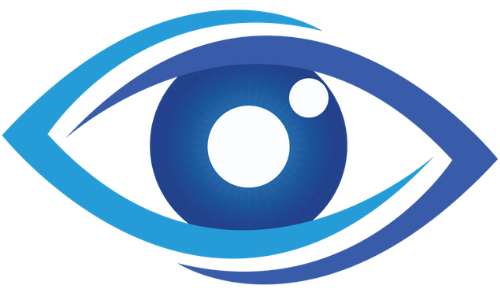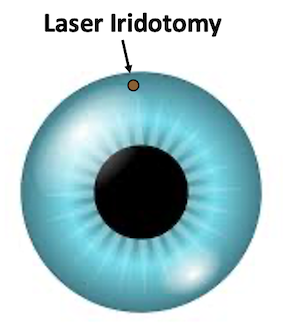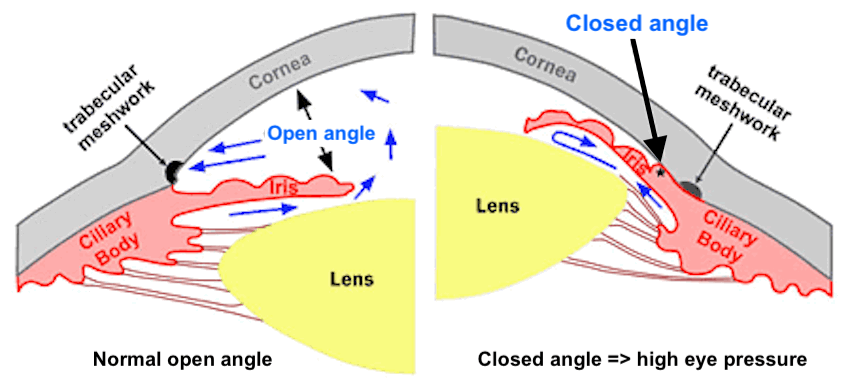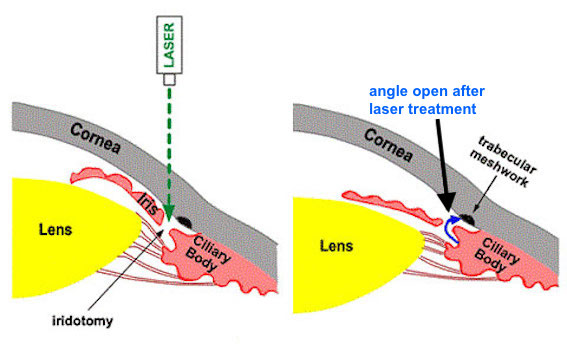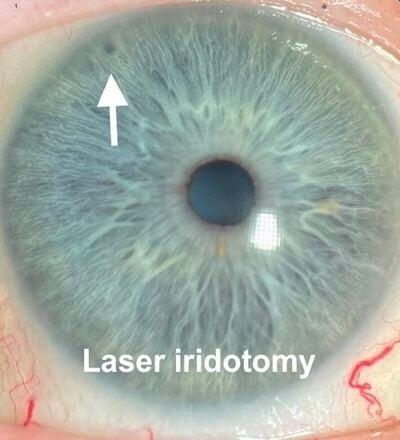YAG laser iridotomy is a type of laser treatment to make a small hole (opening) in the peripheral iris (coloured part of the eye). This hole is called an “Iridotomy”. The aim of the hole is to assist fluid flow from the front part of the iris to the other side and then out of the eye through drainage channels called the trabecular meshwork.
YAG Laser Iridotomy
What is YAG laser iridotomy?
YAG laser iridotomy is recommended for patients who may have a narrow anterior chamber angle. The narrow angle can get blocked in certain situations, and this may compromise the drainage of the fluid inside the eye. This will lead to a sudden rise in eye pressure, causing a condition called “Acute Glaucoma”. High eye pressure can damage the nerve of the eye and may lead to vision loss.
This laser opening will dramatically decrease this risk as it will allow fluid to flow freely inside the eye.
How to know if I have narrow angles?
This is usually picked up on a routine examination by the optician or by an eye specialist. The optician may refer you for an eye specialist’s opinion if he feels the angle of the front part of the eye is narrow or the eye is at risk of angle closure.
You may have no symptoms at all. However, some patients may report occasional headaches or episodes of blurred vision that can occur while watching TV in a dark room, reading, or after emotional stress.
How is laser iridotomy performed?
YAG laser iridotomy is performed at the eye outpatient clinic. The doctor will put some drops to make your pupils small. Then you will be taken to the laser room. You will be asked to sit on a machine very similar to the eye examination machine.
The doctor will apply some numbing drops, put a contact lens to stabilise the eye and perform the laser. The treatment takes only a few minutes. During the laser treatment, you may hear some clicking sounds, and you may see some bright lights or flashes. The doctor may use some drops to lower the eye pressure before or after the laser treatment. The treatment is not painful and is effective in most cases.
What happens after laser treatment?
Following the laser treatment, you will be asked to wait for 30-60 minutes for the doctor to check the eye pressure and confirm the hole made in the iris is large enough. You will be given some anti-inflammatory drops to use at home for 1-2 weeks after the laser procedure.
The doctor will arrange to review you again in 2-4 weeks to check the eye pressure and to make sure the laser hole is working correctly.
What are the benefits?
The laser treatment is performed to prevent a sudden rise in eye pressure if you are at risk. Without this treatment, you are at risk of developing sudden glaucoma and irreversible loss of vision. It is important to remember that it will not restore any sight, nor will it improve your sight. The laser treatment is to prevent a sudden rise in pressure within your eye.
What are risks of YAG Laser Iridotomy?
YAG laser iridotomy is a very safe and effective treatment in most cases. However, like any procedure, there is a small risk of complications, such as:
- Temporary inflammation inside the eye (all patients are advised to use a short course of anti-inflammatory drops after the laser treatment).
- Temporary increase in eye pressure (often treated with drops).
- Small bleeding in the front part of the eye after the laser (uncommon). In most cases, it clears in a few days.
- A cataract (cloudiness of the lens) may develop in the eye that received laser treatment (rare).
- Sometimes, the hole may scar or close after a while. This may require another laser treatment (uncommon).
- Glare or dysphotopsia as a result of light passing through the hole made by the laser (uncommon).
Is there any alternative to YAG laser iridotomy?
For patients who might feel that YAG laser peripheral iridotomy is not quite the right procedure for them, the other option is to perform lens extraction surgery (similar to cataract surgery).
Eyes with narrow angles are known to have a slightly crowded front part of the eye. Their risk of angle closure may increase over time as the lens inside the eye continues to increase in size with age. Therefore, lens extraction can help to open the angle of the eye and prevent angle closure.
A large research study called the EAGLE study found that early lens extraction surgery can be an alternative to YAG laser peripheral iridotomy treatment and can be used as an initial treatment.
